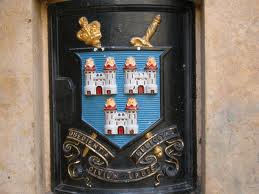A note about Dublin coddle.
The universal comfort food of the Irish capital appears to be unknown elsewhere, not least in Ireland beyond the Pale. Alan Davidson and Regina Sexton, who has been described as the pre-eminent historian of Irish food, omit the dish from The Oxford Companion to Food but do cover other iconic dishes like barm brack and Irish stew.

Dublin coat of arms
In The Complete Book of Irish Country Cooking, the esteemed Darina Allen includes a short essay called “In search of Dublin Coddle.” She explains that “[f]or years I was intrigued by Dublin Coddle. It sounded utterly revolting and when I attempted to make it from the recipes I could find it looked and tasted revolting too.” (Allen 120)
Not exactly a testimonial; perhaps Allen got her recipe from Monica Sheridan, which would account for her initial distaste. The Sheridan version is ridiculous and revolting, as the Editor points out in “Is there an Irish cuisine?” (in the critical) Although we are unaware of other bad written versions of coddle, this is one of those recipes that circulates more widely in the collective memory of a city than in books.
Happily for Allen and her readers, the dish still intrigued her despite those early and revolting acquaintances with it. When she left Cork for Dublin to seek out its secrets, Allen duly played the oral history game by chatting up cab drivers rather than consulting a library. To good effect; at least one of them gave her an authentic recipe, even if another described a bowdlerized version of coddle. It is analogous to those depictions of New World animals painted by early sixteenth century European artists who had never seen them. With its tomatoes and other illegal aliens, the renegade coddle sounds like a dish concocted by an Irish recluse ignorant of Italy who misunderstood a fanciful description of its food that someone with a faint recollection of the cuisine had given him.
Theodora FitzGibbon notes that Dublin coddle “has been a favourite dish since the eighteenth century” and connects it to Swift. (FitzGibbon 120) Coddle also surfaces elsewhere in the Irish literary landscape. It appears in the work of Joyce, both in Dubliners and one of the rare comprehensible passages of Finnegan’s Wake; “Oh, yes, Dubliners used love have coddle on a Saturday.” O’Casey liked the dish, Molly Keane has published a recipe (it is the same as FitzGibbon’s but appeared two years later), and Veronica Jane O’Mara and Fionnuala O’Reilly entitled the American edition of their Irish literary cookbook A Trifle, A Coddle, A Fry.
FitzGibbon first published her recipe for Dublin coddle during 1969, in A Taste of Ireland, and followed up in 1983 with a better version from Traditional Irish Food. The one that Allen got from Kevin Dunn, published in 1995, is identical to the second of the two. It therefore is more than passing strange that Allen, a noted chef, food historian and prolific cookbook author, remained unaware of the authentic dish for so long. Perhaps her ignorance has been feigned in favor of a colorful story about cab rides and cooking with Dunn, “born and bred in the liberties, in the heart of Dublin.”
In any event it sounds like Allen and Dunn had a good time in her kitchen. She peeled and chopped, he shopped and seasoned, and they produced a humble revelation. Allen was astounded:
“It still looked distinctly unappetizing… but surprise, surprise, it tasted absolutely delicious! (I’m not joking ; delicious is not too strong a word for this dish.)…. Now I understand why this simple, good-humored dish is such a favorite…. It’s comfort food at its best.” (Allen 120)

The real recipe for coddle is plain; think of a pork based variation on Irish stew. All you want is bacon, onion, parsley, potato, sausage and scallion. Some cooks thicken their coddle with cornstarch or, imaginatively, white pudding. The pudding is a good if nontraditional addition that adds a depth of flavor to the dish without altering its character. Choose unsmoked lean Irish or English bacon; failing that, go with some mild ham or Canadian bacon. Smoked American or ‘streaky’ bacon, while wonderful, is too fatty and assertive for coddle. You want traditional bangers with a trace of cereal too, the flavor and texture are right. Butter your serving of coddle and never take it to table without some kind of bottled brown sauce.
Coddle is cheap and easy. Once you have peeled and cut, you layer everything into a pot, add some water and simmer away. Coddle cooks itself unattended with great forgiveness; timing is flexible and the dish will not overcook, so it can simmer at the ready. All of these are reasons why coddle has been a Saturday night tradition for generations of Dubliners. You could stagger home from the public house at any hour after too many pints of plain and balls of malt for something soothing.
Nothing could be better.
The annotated bfia recipe for Dublin coddle appears in the practical.
Sources:
Darina Allen, The Complete Book of Irish Country Cooking (New York 1995)
Theodora FitzGibbon, Irish Traditional Food (New York 1983)

